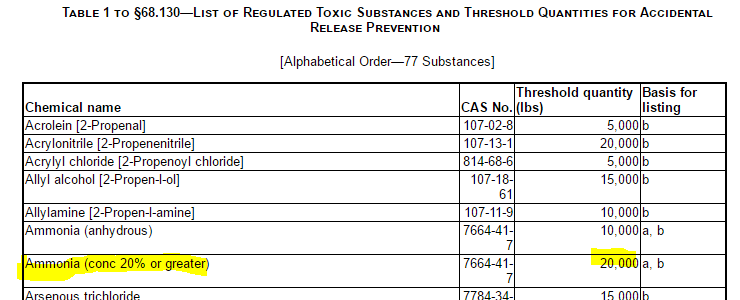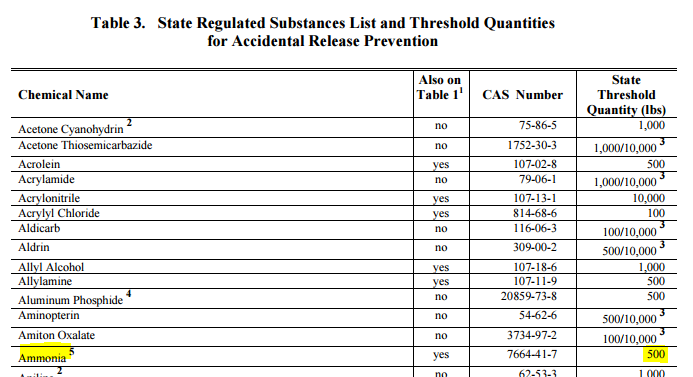CalARP and Aqueous Ammonia
As we have summarized in a previous blog post, the CalARP regulation (Title 19 CCR, Division 2, Chapter 4.5) closely models USEPA’s RMP regulation (Title 40 Part §68) with the most notable difference being that the CalARP chemical list is longer and the threshold quantities are lower when compared to RMP. With regard to anhydrous ammonia, it is fairly well known that the threshold quantity in RMP is 10,000 lb, while the CalARP threshold is 500 lb (20x lower). Aqueous ammonia is also a regulated substance in the RMP regulation, but only when in concentrations greater than 20%.

CalARP, on the other hand, simply lists “Ammonia” as a regulated substance and does not differentiate between anhydrous and aqueous forms.

Both CalARP and RMP require that mixtures of greater than 1% of regulated toxic substances be considered when determining if the threshold quantity has been exceeded (Title 19 CCR §2770.2(b)(1)(A) and Title 40 §68.115(b)(1)). Therefore, the CalARP applicability determination for an aqueous ammonia solution requires some analysis.
The following is the applicability analysis for a hypothetical facility with a 5,000 gallon tank full of 18% aqueous ammonia:
- PSM Applicability: Not subject to PSM since ammonia solutions less than 44% are not included on the list of acutely hazardous substances.
- RMP Applicability: Not subject to RMP since ammonia solutions less than 20% are not included on the list of regulated substances
- CalARP Applicability:
- Specific gravity of 18% aqueous ammonia: 0.9295
- Density of 18% aqueous ammonia: 8.34 lb/gal x 0.9295 = 7.75 lb/gal
- Mass of aqueous ammonia: 5,000 gal x 7.75 lb/gal = 38,750 lb (aqueous ammonia)
- Mass of ammonia: 38,750 lb x 18% = 6,975 lb (ammonia)
- The aqueous ammonia process is subject to CalARP since it exceeds the threshold quantity of 500 lb
For more information regarding this topic (including an additional example), refer to Page 75 of the CalARP Program Administering Agency Guidance, Page 75.

Leave a Reply